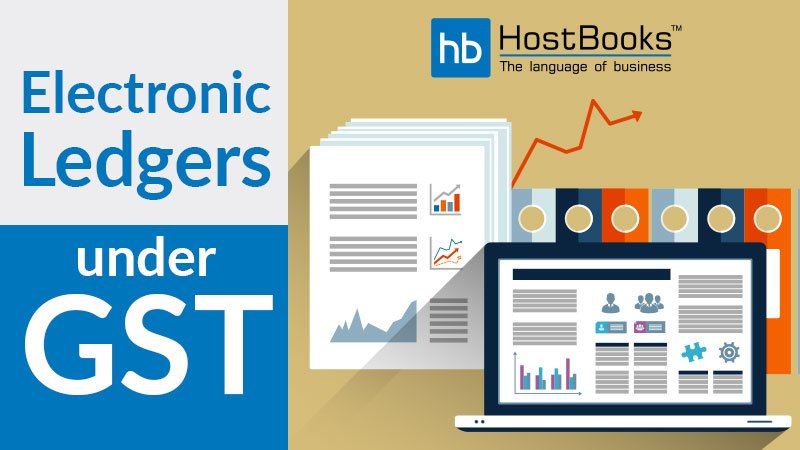What are the various types of Electronic Ledgers under GST?

Under the Goods and Services Tax, the taxpayers can maintain electronic ledgers on the GST portal. Whenever a taxpayer undertakes an activity related to these electronic ledgers, the concerned ledger then gets updated in real-time. Also, the details in the electronic ledgers get auto-populated from previous returns that were filed.
The various types of electronic ledgers under GST are:
- Electronic Cash Ledger
Any online payment by the taxpayer gets reflected in the electronic ledger. The payment can be made via internet banking, debit card, credit card or over the counter payment. If the amount of GST that is to be paid exceeds 10,000 INR, the same has to be paid only via banking platform. The taxpayer while making the payment needs to specify the head under which the payment is to be credited. The major heads include CGST, SGST, IGST and the minor heads are tax, interest, penalty, fees, etc.
- Electronic Input Tax Credit Ledger
This ledger keeps a track of all the taxes paid by the taxpayer on the inputs. The electronic input tax credit ledger gets auto-populated on the basis of GSTR-1 and GSTR-2 filed by the taxpayer. The amount that gets credited in this ledger can be utilized only towards the payment of taxes. Hence, this amount cannot be used for the payment of interest, penalty or late fees. However, there is a fixed order to be followed while paying out the taxes with credit amount of ITC ledger.
- The amount of IGST credit can be used to discharge the liability of IGST first, followed by CGST, SGST, and UTGST.
- The amount of CGST credit can be used to discharge the liability of CGST followed by IGST. However, it cannot be used to make the payment of SGST.
- The amount of SGST or UTGST cannot be used to discharge the liability of CGST but the same can be utilized towards the payment of SGST/UTGST followed by IGST.
- Electronic Liability Ledger
The liability of a taxpayer under the Goods and Services Tax (GST) is reflected in the electronic liability ledger. This includes the tax due on GST return filing, penalty, and demands. It also displays the amount that is paid to discharge the liability through the credit balance available in the other two ledgers.
Different types of GST Payment Forms
| S. No | GST Payment Form | Details | Role |
| 1 | GST PMT-01 | Electronic Tax Liability Register | Any tax, interest, penalty, late fee, or any other amount will be debited to this register |
| 2 | GST PMT-02 | Electronic Credit Ledger | All the ITC claims will be credited to this ledger |
| 3 | GST PMT-03 | Refund to be re-credited | Refund of unclaimed ITC, if rejected, the amount debited from the Electronic Credit Ledger, will be re-credited by order of a proper officer |
| 4 | GST PMT-04 | Discrepancy in Electronic Credit Ledger | Any discrepancy in Electronic Credit Ledger is communicated to an officer through this form |
| 5 | GST PMT-05 | Electronic Cash Ledger | Any tax, interest, penalty, late fee, or any other amount to be deposited in cash are credited to this ledger |
| 6 | GST PMT-06 | Challan for deposit of tax, interest, penalty etc. | Generate and pay a challan |
| 7 | GST PMT-07 | Application for discrepancy relating to payment | This application is meant for the taxpayer where the amount intended to be paid is debited from his account but CIN (Challan Identification Number) has not been generated or generated but has not been reported to the Government Portal within 24 hours of debit |
GST Electronic Ledgers FAQs
- Who all can access the Electronic Cash Ledger?
It can be accessed by the taxpayer, authorized signatories, GST practitioner, and the Jurisdictional Officials.
- If an amount is deposited in the Electronic Cash Ledger by mistake, what happens to that amount?
In this case, the amount will remain intact in the Electronic Cash Ledger. This amount can be used to discharge liabilities or can be claimed as a refund.
- Are the funds in the Electronic Cash Ledger inclusive of Input Tax Credit?
The funds in the Electronic Cash Ledger doesn’t include the Input Tax Credit (ITC).
- Does a Departmental Officer have the power to debit the cash ledger in case an amount to be paid is due?
Yes, the departmental officer has the power to debit the cash ledger in certain exceptional circumstances when the amount of additional demand is not stayed by the Appellate Authority, Tribunal, or Court.
- Are the funds in the Electronic Cash Ledger inclusive of TDS and TCS?
Yes, the funds in the Electronic Cash Ledger includes the TDS and TCS. Also, the same can be utilized to discharge the liabilities.
- What is to be done if the payments made through challans doesn’t get reflected in the cash ledger?
If the payment doesn’t get reflected, then a grievance must be raised on the GST Portal 24 hours after the payment is made successfully and the same is communicated by the bank to the taxpayer using Form GST PMT-06.
- What should be the course of action if the figures in the cash ledger appear to be incorrect?
A grievance can be raised on the GST Portal via Form GST PMT-04.

Try HostBooks
SuperApp Today
Create a free account to get access and start
creating something amazing right now!














